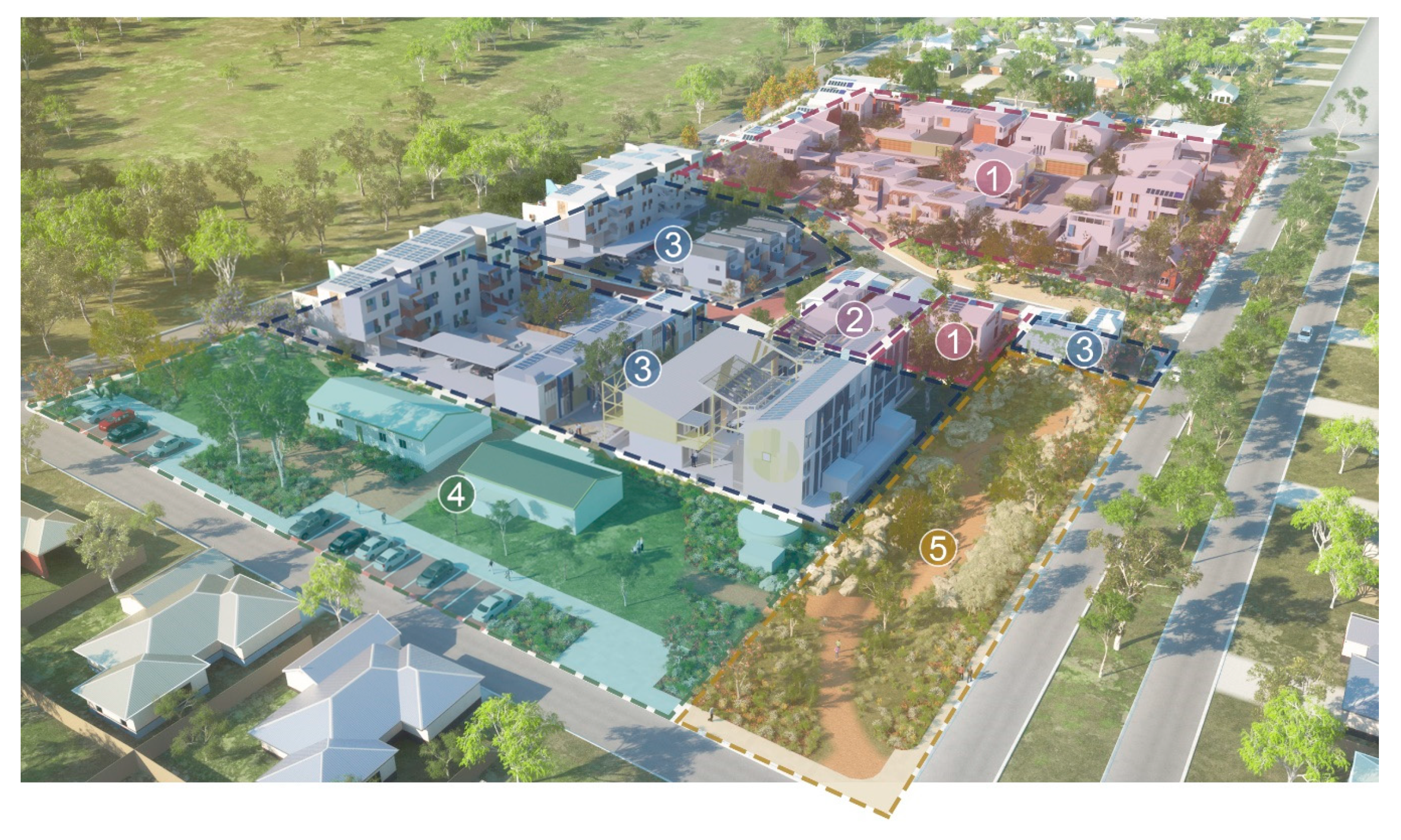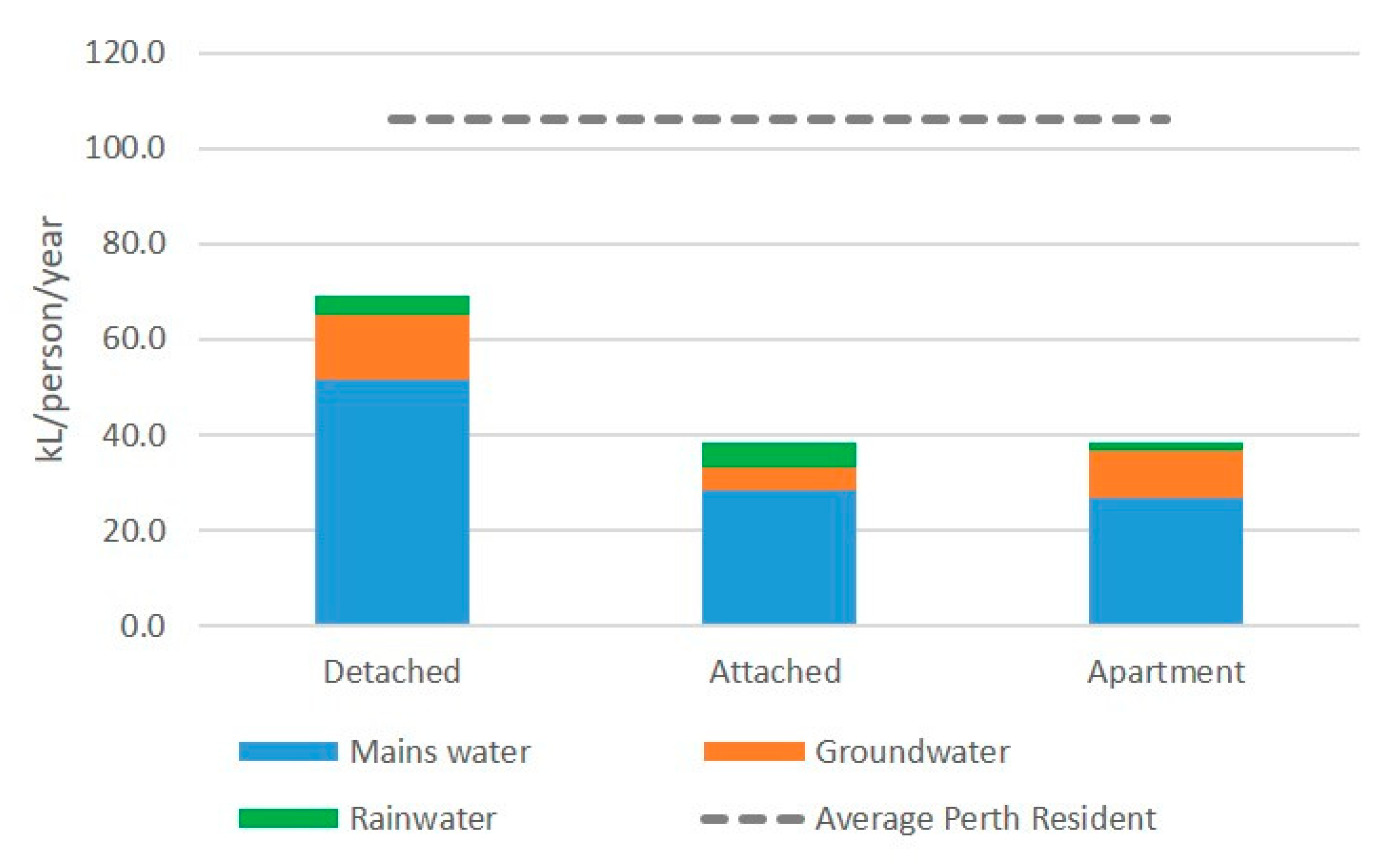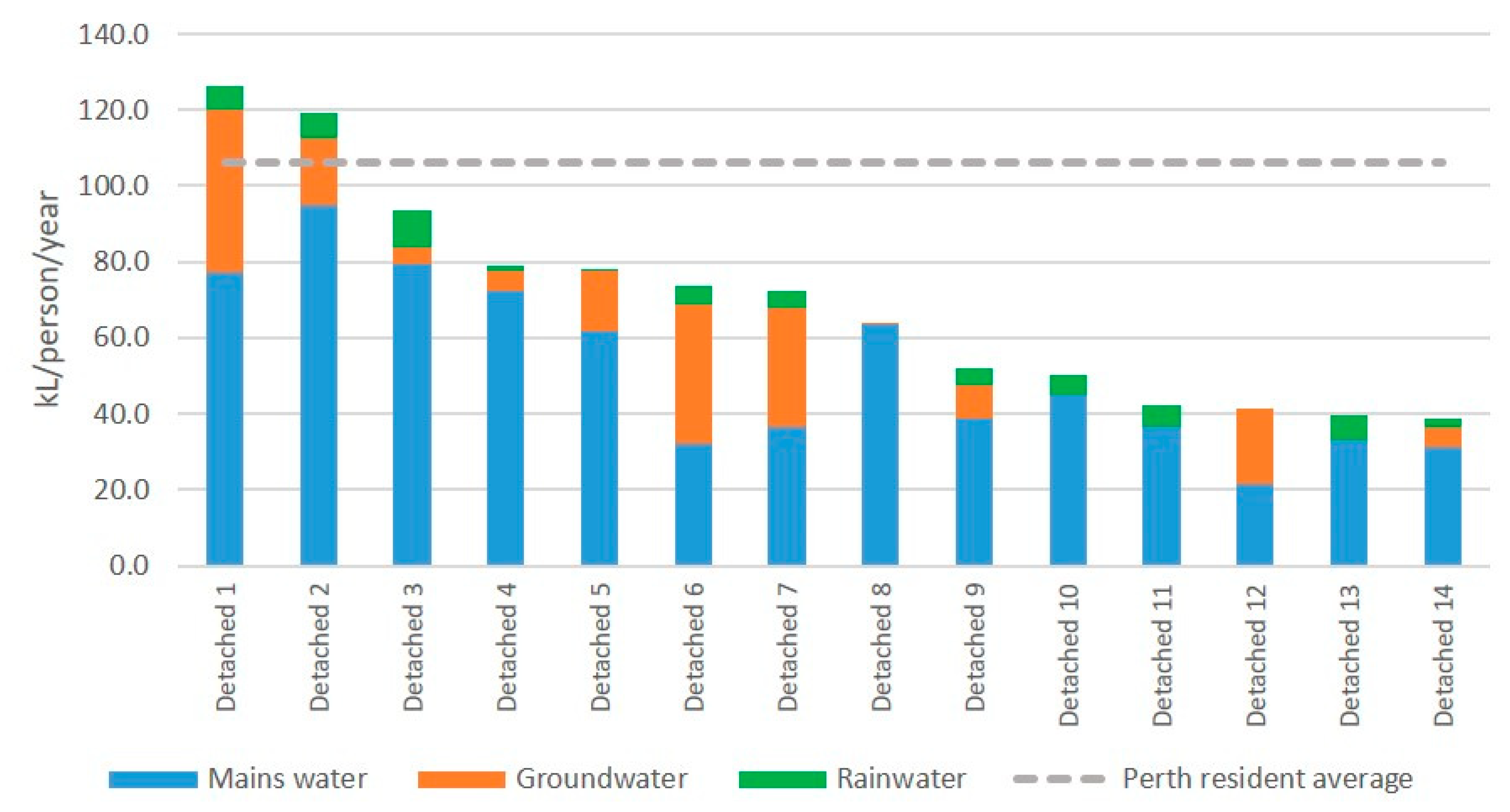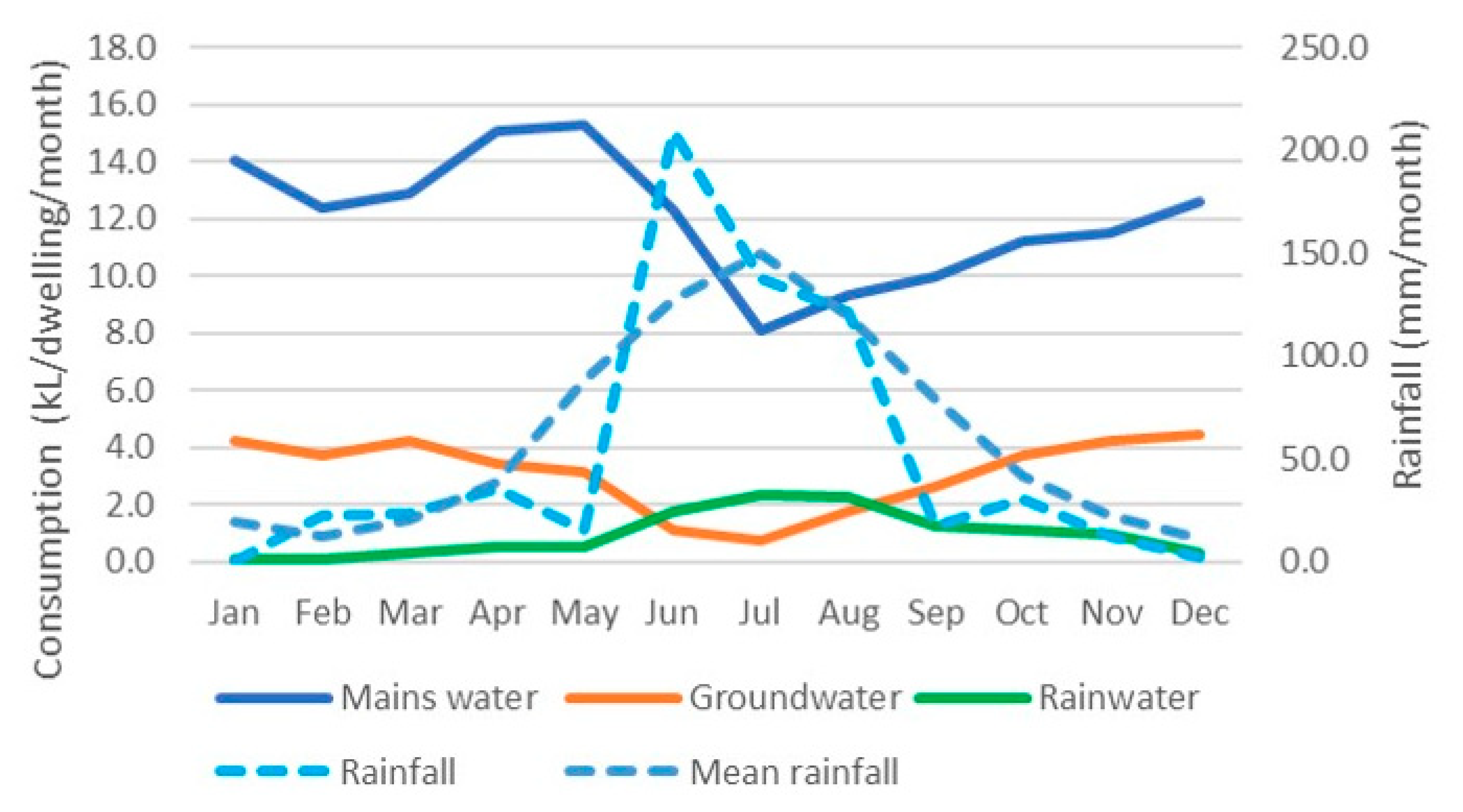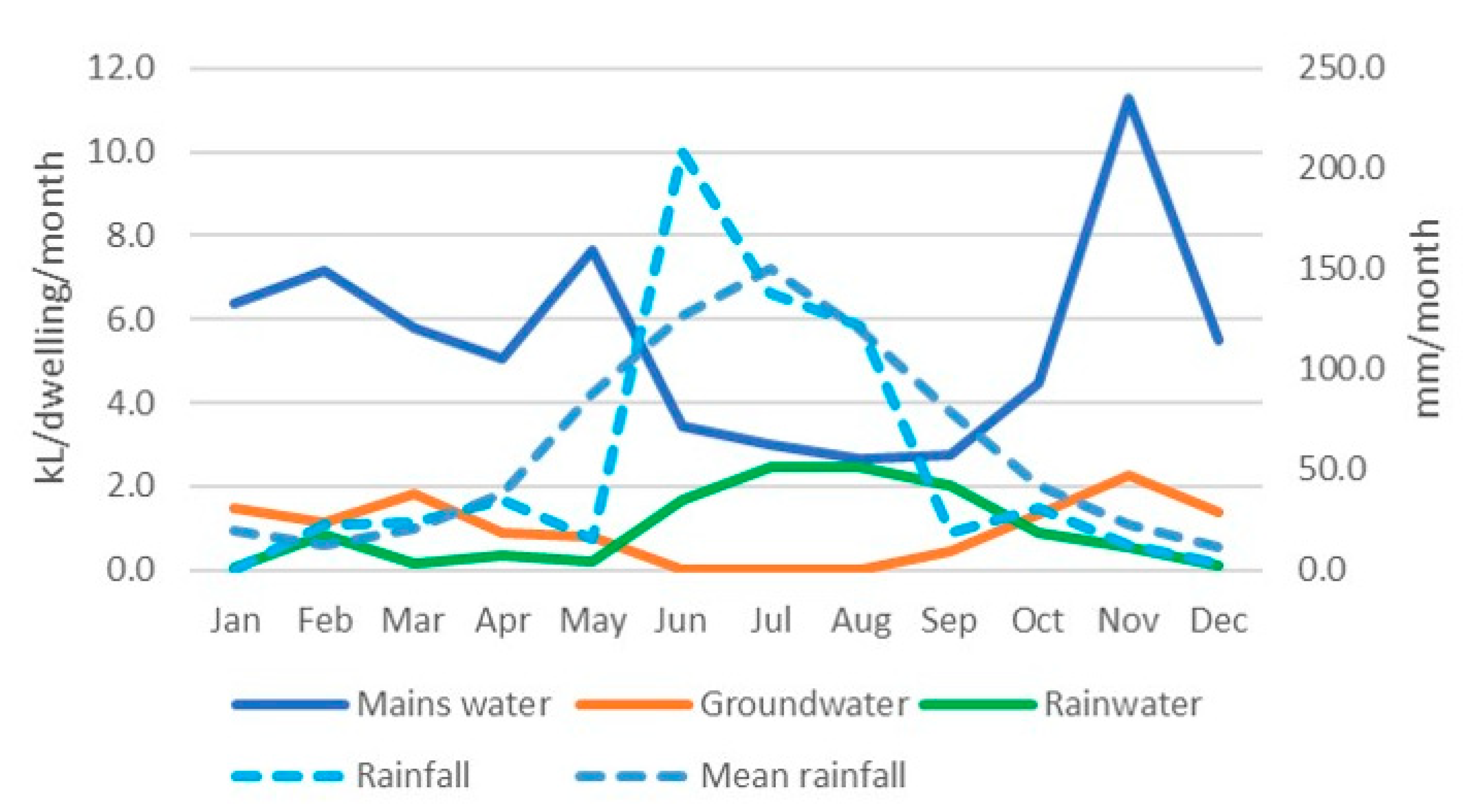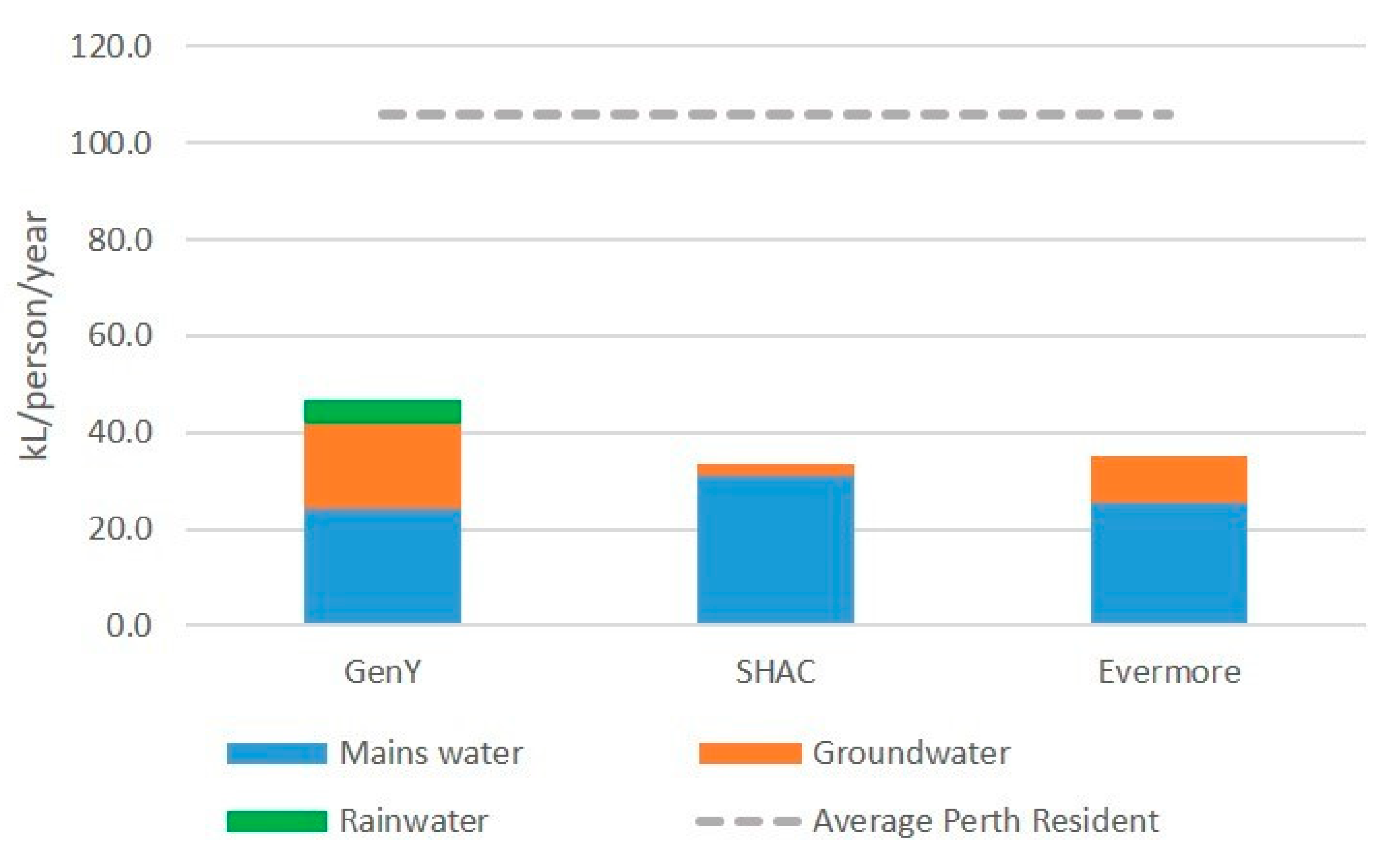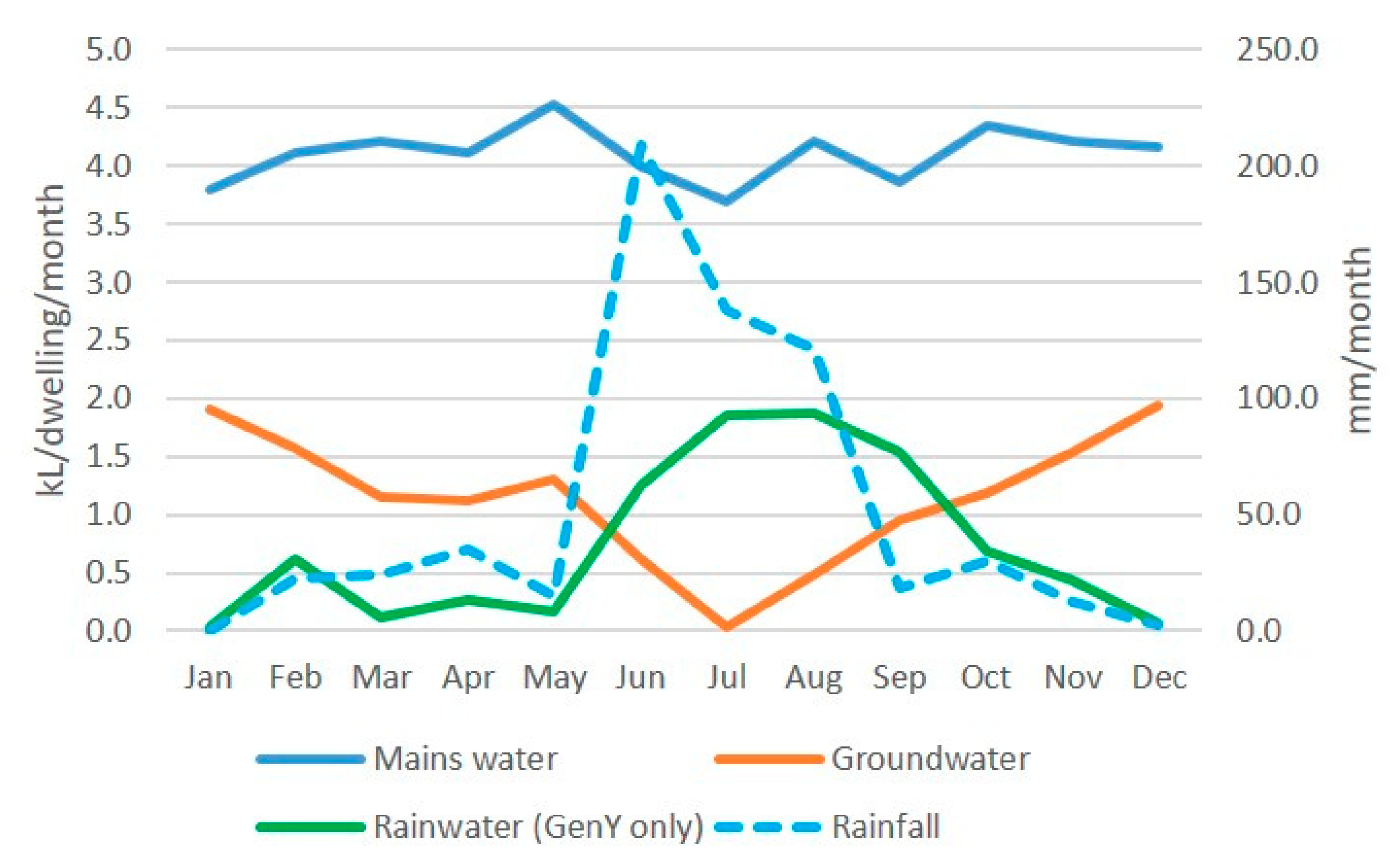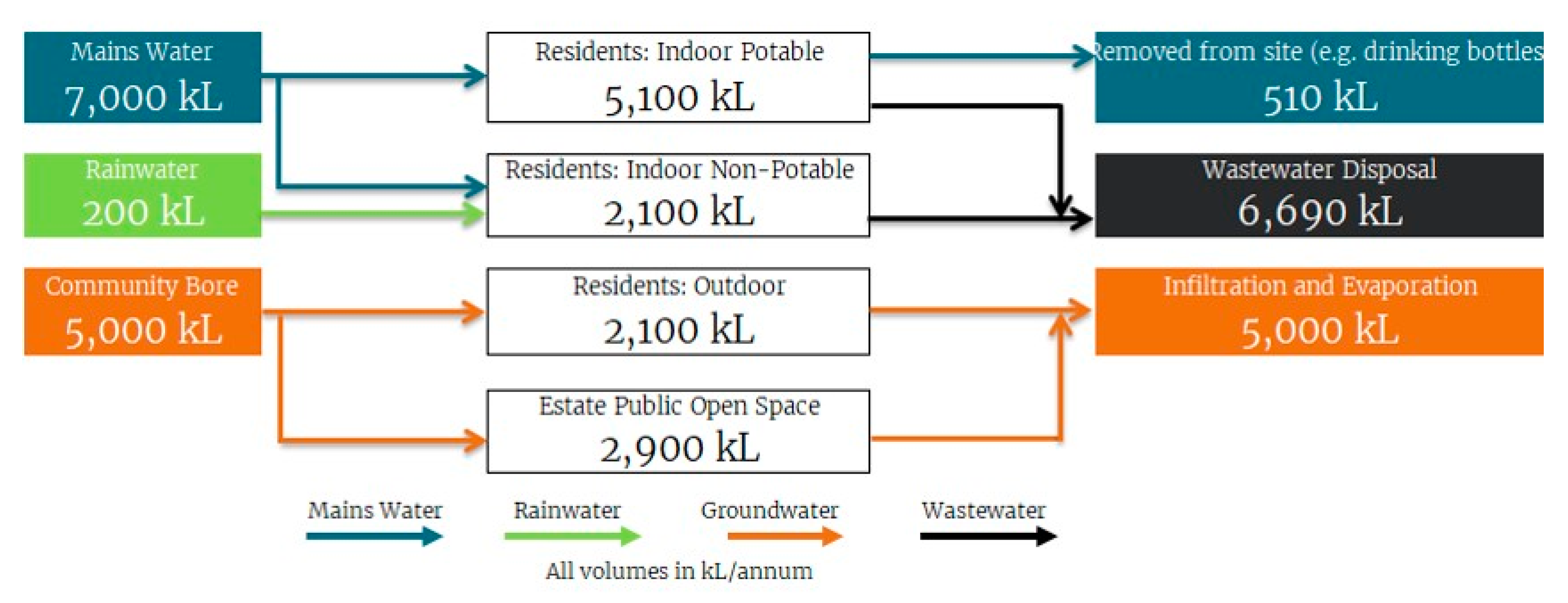1.1. Background
Water conservation is an issue of increasing importance globally [
1]. In Australia, water reserves support ecosystems of international significance but are under pressure from a drying climate and increasing urban water demand [
2]. Traditionally, urban water supplies have been sourced from streamflow into dams and groundwater aquifers; however, with declining rainfall and subsequent reduced streamflow, alternative water sources have to be found [
2]. In Perth, the capital city of Western Australia, urban water sources have changed from being supplied from dams (88%) and groundwater (12%) in the 19060s to now being sourced from seawater desalination (48%), groundwater (40%), dams (10%), and groundwater replenishment technology providing the final 2% [
3,
4]. Along with changes in the sources of water, the energy intensity of urban water has also increased, with desalination more energy intensive than conventional freshwater sources, along with the associated infrastructure costs [
5,
6]. A reduction in urban water use is therefore ideal to reduce pressure on existing supplies, energy demand, and resultant greenhouse gas emissions.
After water use in the bathroom (shower and bath), laundry practices use the largest amount of water inside the house across Australia [
7]. Outdoors, water use in gardening practices is also an intensive use of water [
8]. Variations in water use in different dwelling typologies has also been identified as an influence in household water use [
9,
10]. Water sensitive urban design (WSUD) principles can address outdoor water use, while changes in water fixtures can have an immediate impact on household water use when paired with additional behaviour change measures [
9,
11]. WSUD reduces the impact of stormwater runoff events by directing water into infiltration devices (tree pits, swales, and underground galleries) within the urban form that also replenish groundwater aquifers in the region [
12]. It also includes the harvesting of rainwater and stormwater for potable and non-potable use, along with reducing the urban heat island effect through greening of urban spaces [
13]. Households can complement their use of mains water sources through rainwater, greywater, or groundwater sourced through a bore either on-site or through precinct wide shared systems [
12].
Practical demonstrations of WSUD and household level water efficiency measures are required to assess their suitability to specific climates, regulatory situations, and stakeholder influences. This can be done through intervention projects termed ‘living laboratories’ [
14,
15,
16]. These sites are demonstration projects that are based in real-life settings that enable various stakeholder engagement, regulatory, and technology combinations to generate learnings [
16]. The entire life cycle of a development or technological innovation can be studied in living laboratories, from conception of projects, design stages, building or installation, and finally the occupancy stage [
17]. The case study outlined in this paper focuses on the design stage of a residential development, outlining the ambitious design targets set, the modelling undertaken to test if these targets are realistic, and discussing the governance and technology implications of such an approach. This highlights the importance of establishing sustainable design principles from the beginning of a project [
18]. Other living laboratory projects around Australia have discussed a similar approach and their ability to further realistic approaches to sustainable water management [
19,
20,
21].
1.2. Case Study
This paper documents the mains water savings achieved at a 2.2 ha medium density residential infill project near Fremantle, Western Australia (WA). The project, known as the ‘WGV precinct’, located in the suburb of White Gum Valley [
22], was delivered by the WA State Government land development agency DevelopmentWA, with civil works commencing in 2014. At the time of publication, WGV was approximately 80% built out and occupied. Objectives and targets were set for the WGV precinct around exemplary WSUD, fit-for-purpose water use, and reducing mains water consumption, while also placing emphasis on creating a highly livable environment with quality green space.
The project addresses two important issues in Western Australian land development: infill development that is making more efficient use of existing infrastructure and amenity, and WSUD in a location with a drying climate that is increasingly reliant on high embodied energy water from seawater desalination for the mains supply (nearly 50%). [
23]. The overall energy intensity of Perth mains water is 2.41 kilowatt hours per kilolitre [
24], while the energy intensity of desalinated mains water is higher at 4 kilowatt hours per kilolitre, or more [
25]. This energy intensity is an important part of the interest in reducing mains water consumption, as well as the capital and operational cost of desalination plants.
The drive to reduce mains water consumption has seen varied government responses. Responsibility for water resources in Western Australia is shared between the Water Corporation and the Department of Water and Environmental Regulation (DWER). DWER is broadly responsible for water source allocation and management across the state [
26], while the Water Corporation, a State Government owned operator, primarily provides the direct service of mains water supply and wastewater removal to homes and businesses connected to the mains water network [
27]. Both run programs intended to address water efficiency and resilience in the urban context [
28,
29]. The Water Corporation provides recognition, through their Waterwise Development program, to land development projects that have met certain criteria around water performance [
30]. At the Commonwealth Government level there is a national scheme, the Water Efficiency and Labelling Standards (WELS) scheme [
31,
32], to address water efficiency of appliances, fixtures, and fittings. Despite these various programs, there are very few attempts to make water performance and management a key theme of a residential development evident in the literature.
In another innovative approach, the WGV precinct has set a series of ambitious targets at the beginning of the project for water efficiency and design that are above the standard in Western Australia. The implementation of a comprehensive metering and monitoring system was undertaken to robustly test the outcomes in a commercially viable and mainstream residential precinct to highlight approaches that can be taken by designers and developers of households and precincts to go beyond business-as-usual water practices.
1.2.1. WGV Typologies
There are three main typologies, or forms of residential dwelling, at WGV:
Detached dwellings: There are 22 detached (no common walls) completed residential dwellings on lots ranging in size from 250–350 m2. A site that had previously been proposed as a group dwelling site has now been subdivided into six lots that have detached dwellings now under construction. Each of these lots has metered connections to mains water and groundwater irrigation supply. Most also have a rainwater system plumbed into the home that is also metered.
Attached dwellings: There is one duplex site at WGV. The two attached dwellings on this site share a rainwater system, and their mains water supply is connected at a single meter. They are connected to the community groundwater bore for irrigation supply, again at a single point of supply for the site.
Apartments (multi-residential dwellings): There are four apartment sites at WGV, with three built and occupied as of mid-2020. As well as individual apartment metering of mains water consumption, the complexes have site level metered connections to mains water and irrigation supply. The sites include: the Sustainable Housing for Artists and Creatives (SHAC) apartments that contain 12 dwellings plus two studios, which have water consumption being monitored; the Evermore apartments (24 dwellings), which are almost fully occupied; GenY Demonstration House, which consists of three apartments, all occupied, on a single house footprint; and Lot 2, which will be developed in the future as an apartment building.
Figure 1 shows the layout of WGV including lot arrangement, roads, laneways, and verges. It also shows early concepts of the eventual building footprints at WGV, which is a close approximation of what has now been constructed.
1.2.2. Occupancy
The actual occupancy figures for the various typologies at the WGV precinct are not known. The Australian Bureau of Statistics does not provide occupancy rates specific to these typologies, so suitable figures have been inferred from what is available for use in water modelling.
Table 1 shows the occupancy figures used in this paper along with the expected accommodation figures, totally approximately 190 residents across the three typologies [
13].
1.2.3. Research and Demonstration Programs at WGV
The WGV precinct integrates a unique set of leading-edge mains water reduction strategies with climate sensitive considerations and creative urban greening to be the first certified ‘One Planet Community’ in Western Australia [
34]. The WGV Waterwise Development Exemplar is a collaboration between DevelopmentWA, Water Corporation, and other parties to monitor, analyse, and communicate the water management outcomes at WGV. The WGV Waterwise Development Exemplar is testing the objective of reducing mains water consumption by 60–70% compared to the Perth average mains water consumption through various initiatives deployed at the site, including efficiency measures, rainwater harvesting, and a precinct-scale groundwater irrigation scheme for both residential and public green space [
13].
